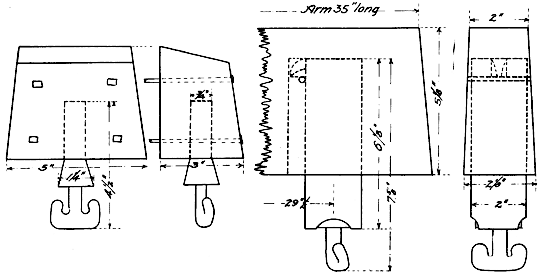[Trade Journal]
Publication: The Journal of Electricity, Power and Gas
San Francisco, CA, United States
vol. XXII, no. 2, p. 19-20, col. 1-2
THE FIRST UNDERHUNG INSULATORS
By A. S. Kalenborn
When the new type of underhung, high-tension insulator was introduced, most of us were impressed by the radical change from the old pin-supported type, and, no doubt, considered the idea of underhanging as quite original and entirely new.
During a recent trip into the Sierras in the vicinity of Lake Tahoe, I came across the antiquated, almost forgotten prototypes of these new high-tension insulators. One of these used by the Central Pacific Railroad is quite an elaborate piece of work, consisting of three separate parts, which are cemented together with sulphur, and an additional iron pin or spike to secure the combination within the cross-arm. A thin cast-iron cup with a lug near the closed end was secured, open end downward, within the arm by a pin, as indicated in the line drawing. Within this, cemented by means of sulphur, was an open-mouthed bottle of glass, and "sulphured" within the bottle was the hook for holding the wire.
 |
| Fig. 1. Western Union Insulator. Central Pacific R. R. Insulator. |
Figure 1 shows the arm and the method of supporting the insulator. The wire was held without a tie by being bent into the hook, the kink formed thereby preventing displacement or slipping. The arms were treated with some preservative, apparently bitumen, and are in good condition, although they have been exposed to the weather for many years.
On the top of the enclosing cast-iron cylinder of the insulator, which, with the pin, is heavily galvanized, are the words, "Brooks' Pat. August 6, 1867." It seems, therefore, that before some of us were born these underhung insulators were out in the world doing an important work. Later the glass pin-supported insulators superseded these at considerably reduced cost.
The other type of telegraph insulator is simpler, smaller, and of less cost and weight than the first, as it weighs complete only 5 ounces, as compared to 1 pound 10 ounces for the larger one.
This one, which was used on the Western Union line along the wagon road from Truckee to Lake Tahoe, and which, as shown, consists of only two component parts, the galvanized iron hook and a rubber sleeve cast onto the under side of an arm or block secured to a pole or a tree. The Truckee-Tahoe line was run through the forest, and small blocks, as shown, were nailed to the trees, the bark of which has in many instances almost enclosed them at this date.
Around the shank, apparently stamped into the rubber, are the words, "Goodyear's Patent. May 6, 1851," which takes us back to the very early days of the telegraph, or eighteen years prior to the laying of the first transatlantic cable.
Thus we see that our "newest" insulators are in reality but a modification of the earliest ones, and the principle long discarded is the one which solves the problem of utilizing extra high voltages.
